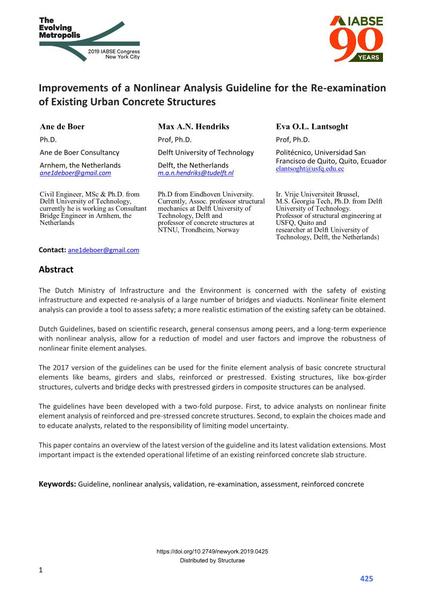Improvements of a Nonlinear Analysis Guideline for the Re-examination of Existing Urban Concrete Structures

|
|
|||||||||||
Bibliographic Details
| Author(s): |
Ane de Boer
(Ane de Boer Consultancy)
Max A. N. Hendriks Eva O. L. Lantsoght |
||||
|---|---|---|---|---|---|
| Medium: | conference paper | ||||
| Language(s): | English | ||||
| Conference: | IABSE Congress: The Evolving Metropolis, New York, NY, USA, 4-6 September 2019 | ||||
| Published in: | The Evolving Metropolis | ||||
|
|||||
| Page(s): | 425-431 | ||||
| Total no. of pages: | 7 | ||||
| DOI: | 10.2749/newyork.2019.0425 | ||||
| Abstract: |
The Dutch Ministry of Infrastructure and the Environment is concerned with the safety of existing infrastructure and expected re-analysis of a large number of bridges and viaducts. Nonlinear finite element analysis can provide a tool to assess safety; a more realistic estimation of the existing safety can be obtained. Dutch Guidelines, based on scientific research, general consensus among peers, and a long-term experience with nonlinear analysis, allow for a reduction of model and user factors and improve the robustness of nonlinear finite element analyses. The 2017 version of the guidelines can be used for the finite element analysis of basic concrete structural elements like beams, girders and slabs, reinforced or prestressed. Existing structures, like box-girder structures, culverts and bridge decks with prestressed girders in composite structures can be analysed. The guidelines have been developed with a two-fold purpose. First, to advice analysts on nonlinear finite element analysis of reinforced and pre-stressed concrete structures. Second, to explain the choices made and to educate analysts, related to the responsibility of limiting model uncertainty. This paper contains an overview of the latest version of the guideline and its latest validation extensions. Most important impact is the extended operational lifetime of an existing reinforced concrete slab structure. |
||||
| Keywords: |
guideline reinforced concrete validation assessment non-linear analysis re-examination
|
||||
